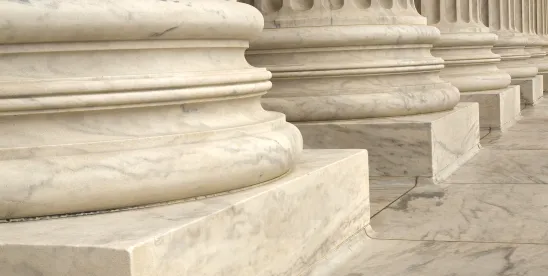On June 24, 2024, the Supreme Court granted a petition for writ of certiorari in Seven County Infrastructure Coalition v. Eagle County, CO, (23-975), a case challenging the scope of an environmental review conducted by the Surface Transportation Board (“Board”) pursuant to the National Environmental Policy Act ("NEPA”) for an 88-mile rail line project in Utah. The question before the Court is whether NEPA requires federal agencies to study the environmental impacts of proposed projects beyond the proximate effects of the action that an agency has no authority to regulate. The petitioners contend that the D.C. Circuit’s decision ordering the Board to study the downstream effects of approving the rail line on the expansion of oil production from oil wells and refineries, which lie outside the Board’s regulatory authority, was in error and contrary to the Supreme Court’s interpretation on the scope of agency authority in Department of Transportation v. Public Citizen, 541 U.S. 752 (2004). This case will give the Supreme Court an opportunity to further clarify the scope of agencies’ NEPA review, especially in the context of analyzing the downstream effects of greenhouse gas (“GHG”) emissions from oil and gas infrastructure projects. A decision from the Supreme Court emphasizing the limits of an agency’s NEPA review could help avoid broad-ranging NEPA reviews that go beyond the agency action at issue and lessen related delays to NEPA review timelines.
Regulatory Background
NEPA imposes procedural requirements for major federal actions, including the granting of federal permits and approvals like those needed for the rail line at issue in the challenged decision. Federal agencies are required to evaluate the reasonably foreseeable environmental effects of major federal actions – whether direct, cumulative, or indirect—and consider reasonable alternatives. NEPA requires only that the agency decisionmakers make informed decisions, not that an agency choose the environmentally preferable alternative.
Determining the scope of a “reasonably foreseeable indirect” effect is often contentious. In the Supreme Court’s seminal NEPA case, Public Citizen, the Supreme Court held that “where an agency has no ability to prevent a certain effect due to its limited statutory authority over the relevant actions, the agency cannot be considered a legally relevant ‘cause’ of the effect,” therefore the agency need not consider that effect for the purpose of NEPA review. 541 U.S. 770, 752 (2004). The circuit courts of appeals, however, are split on the interpretation of that decision. The D.C. Circuit (in the case that will be reviewed here) and Ninth Circuit have held that the agency must consider “reasonably foreseeable” effects regardless of the agency’s authority. In contrast, the Third, Fourth, Sixth, Seventh, and Eleventh Circuits agree on a more narrow interpretation: agencies may limit their review to the effects proximately caused by the specific activities within the agencies’ regulatory authority.
Seven County Infrastructure Coalition v. Eagle County, CO
The Board approved a $1.5 billion project for an 88-mile rail line expected to transport crude oil. In the Board’s Environmental Impact Statement for the project, the Board determined that oil and gas development that would result from the project was not an “indirect effect” for purposes of NEPA because the Board lacked authority over the downstream development of oil and gas. Eagle County, Colorado, and environmental public interest groups petitioned the D.C. Circuit for review. The DC Circuit rejected the Board’s interpretation and directed the Board to study the local effects of oil wells and refineries that lie outside the Board’s authority.
The petitioners before the Supreme Court argue that the D.C. Circuit misinterpreted Public Citizen in holding that the Board needed to consider the GHG emissions and other downstream impacts from oil and gas development as a reasonably foreseeable indirect effect of the rail line in its NEPA analysis despite the Board’s lack of authority to prevent, control, or mitigate those effects. In support, the petitioners argue that the Board’s review was sufficient and, consistent with the five circuit courts that have held that agencies are not required to study the environmental effects of activities they do not regulate. For example, the petitioners cite the Eleventh Circuit’s opinion in Ctr. for Biological Diversity v. U.S. Army Corps of Eng’rs, which rejected the D.C. Circuit’s interpretation of Public Citizen and held that it was sensible “for the [agency] to draw the line at the reaches of its own jurisdiction, leaving the effects [] to [] regulators.” 941 F.3d, 1288, 1295–96. The petitioners contend that the broader interpretation adopted by the D.C. Circuit would allow “environmental-policy czars” that deny permits based on issues outside their authority and expertise.[1]
The respondents, for their part, disagree that the D.C. Circuit deviates from the Court’s precedent and argue that Petitioners’ interpretation is “irreconcilable with NEPA’s purpose.”[2] Instead, the respondents argue that the question presented is fact-specific and the agency must consider the full impacts of the project, including impacts on environmental justice communities near the refineries in the Gulf Coast. They claim that consistent with Public Citizen, the downstream GHG effects from the proposed project are well within the Board’s authority to prevent.
The Supreme Court’s decision, in this case, could have important implications for NEPA analyses going forward, including on the scope of the White House Council on Environmental Quality’s new rules, published in May 2024, directing agencies to quantify, where feasible, the reasonably foreseeable GHG emissions from a proposed project. A decision to overturn the D.C. Circuit in this case would avoid broad NEPA reviews and keep an agency’s focus on effects that are more closely related to the authorized activity. Such clarification from the Court could help avoid delays that are often associated with wide-ranging NEPA reviews that are not cabined by the agency action at issue.
The Supreme Court will hear the case in the Fall 2024 term.
[1] Petition for Certiorari, No. 23-975, at 23.
[2] Brief of Respondents Eagle County Colorado et al in Opposition, No. 23-975, at 14.
Abigail Contreras and Jordan L. Bernstein contributed to this article









 />i
/>i

